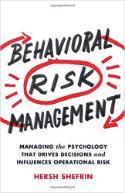
Hersh Shefrin holds the Mario Belotti Chair in the Department of Finance at Santa Clara University's Leavey School of Business. Professor Shefrin is a pioneer of behavioral finance. He has published widely in the area and writes for both academics and practitioners. Professor Shefrin regularly teaches behavioral finance to both undergraduates and graduates. He often speaks on the subject to portfolio managers, security analysts, and financial planners both in the U.S. and abroad. In addition, he is frequently interviewed by the media on financial matters, writes occasional blogs for Forbes and the Huffington Post, and can be followed on Twitter at @HershShefrin.

Professor Shefrin's latest book Behavioral Risk Management was published in December 2015. This book argues that the most important risk management disasters in the preceding fifteen years all have psychological pitfalls at their root. Examples abound: the global financial crisis, the nuclear meltdown at Fukushima Daiichi in Japan which led that country to close down all of its nuclear power plants for several years, the BP Deepwater Horizon disaster in the Gulf of Mexico, and the WHO's late response to the Ebola epidemic that erupted in 2014. Collectively, the examples in the book illustrate a series of do's and don'ts for addressing psychological issues in risk management. Updates to the published version can be found at this link.
In 2001 CFO Magazine listed Professor Shefrin among the “Academic Stars of Finance.” A 2003 article appearing in The American Economic Review, by Pierre-Andre Chiappori and Steven Levitt, included Professor Shefrin among the top 15 theorists to have influenced empirical work in microeonomics. In 2006, Professor Shefrin was awarded an honorary doctorate from the University of Oulu in Finland. Between 2007 and 2012, he was a visiting guest professor at Central South University in Changsha, China. He received the IMCA 2008 Journalism Award from the Investment Management Consultants’ Association. Along with colleague Meir Statman, he received a Graham and Dodd award in 1994 and the 2000 William Sharpe Award for the best paper published in the Journal of Finance and Quantitative Analysis.
In 1999, Harvard Business School Press published Professor Shefrin's book, Beyond Greed and Fear: Understanding Behavioral Finance and the Psychology of Investing. BG&F is the first comprehensive treatment of behavioral finance written specifically for practitioners. In 2009, J.P Morgan Chase recognized BG&F as one of the top ten books published since 2000. In 2007, Oxford University Press, who assumed publication of the book, released an edition with a revised preface to reflect recent events and developments. The book is used around the world as a textbook in courses in behavioral finance, and is part of the CFA Institute curriculum source material. The book is available for purchase through this website. Supplementary instructional materials for using the book can be downloaded from the right side of this page under instructional materials
In 2001, Professor Shefrin edited a three-volume collection, entitled Behavioral Finance, published by Edward Elgar. In addition to seminal papers in this rapidly developing field, these volumes contain some of the pioneering works in psychology, upon which behavioral finance is based.
In 2006, McGraw-Hill/Irwin published Professor Shefrin’s textbook Behavioral Corporate Finance. BCF is the first book to analyze the impact of behavioral phenomena on corporate finance. BCF is written to be used as a supplement in regular MBA level corporate finance classes. Material that will appear in the next edition can be found at the following links:
- http://online.wsj.com/article/
SB10001424127887324299104578531561852942612.html?
mod=wsj_streaming_stream - http://www.forbes.com/sites/hershshefrin/2013/11/08/
why-twitters-ipo-was-really-a-failure/ - http://www.forbes.com/sites/hershshefrin/2013/11/07/
psychological-traps-snare-blackberry-decision-makers/ - http://www.forbes.com/sites/hershshefrin/2014/04/24/
apples-moves-make-the-stock-look-better-but-is-it-worth-more/
Material updating Chapter 2 appears in Professor Shefrin's article, "Free Cash Flows, Valuation and Growth Opportunities Bias," that appears in the December 2014 issue of the Journal of Investment Management and can be downloaded by clicking on this link »
In 2008, Elsevier published the second edition of Professor Shefrin’s book A Behavioral Approach to Asset Pricing. BAAP is the first systematic analysis of how behavioral assumptions impact the pricing kernel that lies at the heart of modern asset pricing theory. The book provides a unified behavioral treatment of the pricing of equities, options, fixed income securities, and mean-variance portfolios.
In 2008, McGraw-Hill published Professor Shefrin’s book Ending the Management Illusion: How to Drive Business Results Using the Principles of Behavioral Finance. This book explains the behavioral traps and biases which typically ensnare managers, and describes how companies can develop a culture of debiasing. Readers will find that the companies identified in the book as having strong cultures have generally performed well since the book was published, while companies identified as having weak cultures have generally not. Readers are encouraged to read how the book described the cultures of Southwest Airlines, Ford, BP, and Citigroup. A simulation game described in the book can be downloaded to the right side of this page under instructional materials.
Since the publication of Ending the Management Illusion (EMI), Professor Shefrin has applied the EMI culture framework to explaining the role that weak culture has played in events such as the financial crisis and the 2010 explosion of Deepwater Horizon while drilling BP’s Macondo well in the Gulf of Mexico.
See abstract_id=152393, http://iveybusinessjournal.com/publication/ending-the-management-illusion-preventing-another-financial-crisis, and http://papers.ssrn.com/sol3/papers.cfm?abstract_id=1769213.
Many of Professor Shefrin’s writing since 2008 have focused on the role played by psychological phenomena in the global financial crisis. A short summary of his views can be found at http://investorhome.com/gfc/hs.htm. Additional longer works can be found at http://papers.ssrn.com/sol3/papers.cfm?abstract_id=1953621, http://papers.ssrn.com/sol3/papers.cfm?abstract_id=1539172, and http://www.russellsage.org/sites/all/files/Rethinking-Finance/Shefrin%20Statman%2001272012.pdf.
In 2010, Professor Shefrin published a monograph entitled Behavioralizing Finance, http://papers.ssrn.com/sol3/papers.cfm?abstract_id=1597934. Behavioralizing Finance surveys the main contributions to behavioral finance, and explores both the strengths and weaknesses of the behavioral approach. In doing so, he suggests how behavioral finance might evolve in the future both to exploit its strengths and address its weaknesses.
One of Professor Shefrin’s current areas of focus is behavioral risk management, the application of behavioral ideas to the practice of risk management. Among Professor Shefrin’s other areas of focus are the application of behavioral concepts to financial decisions made by individuals. In this regard, he serves on mutual fund boards and works with financial firms to provide tools for managing household spending and borrowing.
Professor Shefrin's scholarly articles have appeared in the Journal of Finance, theJournal of Financial Economics, the Review of Financial Studies, the Journal of Financial and Quantitative Analysis, Financial Management, the Financial Analysts Journal, the Journal of Investment Management, the Journal of Investment Consulting, the Journal of Portfolio Management, Quarterly Journal of Finance,Journal of Political Economy, Review of Economic Studies, Journal of Economic Theory, Economic Inquiry, Economica, Journal of Econometrics, Discrete Mathematics, Quarterly Journal of Economics, and the International Economic Review.
In the 1970s and 1980s Professor Shefrin’s co-authored papers in behavioral economics with Richard Thaler were the first to propose a psychological and neurological based theory of self-control. In 1984, an article on dividends by Professor Shefrin and Meir Statman was the first treatment of behavioral finance by financial economists. In 1985, they introduced the concept of “the disposition effect” into the behavioral finance literature, and coined the term. The disposition effect is the tendency to sell winning stocks too early and ride losing stocks too long. This phenomenon is the most studied in the literature on individual investor behavior.
Professor Shefrin completed his PhD at the London School of Economics in the economics of uncertainty; he earned a Master of Mathematics from the University of Waterloo and a BS (Honors) in economics and mathematics from the University of Manitoba.
January 2016